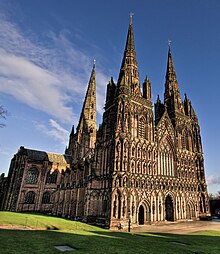Roger Northburgh
| Roger Northburgh | |
|---|---|
| Bishop of Coventry and Lichfield | |

Lichfield Cathedral
|
|
| Archdiocese | Province of Canterbury |
| Appointed | 14 December 1321 |
| Term ended | 22 November 1358 |
| Predecessor | Walter Langton |
| Successor | Robert de Stretton |
| Orders | |
| Consecration | 27 June 1322 by Thomas Cobham, the Bishop of Worcester |
| Personal details | |
| Born | Reputedly Norbury, Staffordshire |
| Died | 22 November 1358 |
| Denomination | Catholic |
| Previous post | Archdeacon of Richmond |
Roger Northburgh (died 1358) was a cleric, administrator and politician who was Bishop of Coventry and Lichfield from 1321 until his death. His was a stormy career as he was inevitably involved in many of the conflicts of his time: military, dynastic and ecclesiastical.
Northburgh was long supposed to derive his name from Norbury, Staffordshire, which was considered his birthplace. Sometimes his name has even been rendered as Norbury, as in the edition of his episcopal register by Edmund Hobhouse. However, the identification is no longer accepted as certain. is, in any case, a very common toponym: even within Northburgh's diocese, there were several examples. Nothing definite is known of his background. He seems to have communicated in Norman French, which makes it likely, but still not certain, that he came from the landed class of French descent.
Northburgh is often said to have been educated at Cambridge University. His interest in the university around 1321 makes this plausible, but there is no direct evidence to support it. He must have acquired an adequate education in Latin to perform his ecclesiastical functions.
Northburgh appears as early as 1306-7, during the reign of Edward I, already employed in the royal wardrobe. This was the recruiting ground from which senior figures in the royal government were drawn. By 1310, under Edward II he was a wardrobe clerk on a wage of 7½d. per day. However, the wardrobe was coming under great pressure from the powerful baronial opposition, the Lords Ordainers, and its funds reducing as they sought to reduce the independent power of the monarchy. In 1311-12, Northburgh accompanied the king as he led an army to Scotland and then across northern England, while the Ordainers, dominated the south.
It is unclear at exactly what point Northburgh was given custody of the Privy Seal, although he definitely held the post by 18 September 1312 and continued in office until 1316. He was not given the formal title of Keeper of the Privy Seal until 1315, apparently the first so-called, although the function had existed for some time. His keepership is regarded as decisive in constituting it as a separate office. The administrators who worked under him, although at first numbered among the wardrobe clerks, became titled “clerks of the privy seal,” thus constituting a separate staff for the first time.
...
Wikipedia
